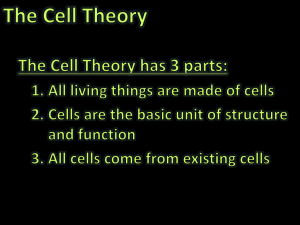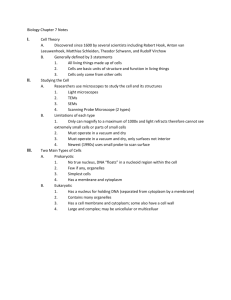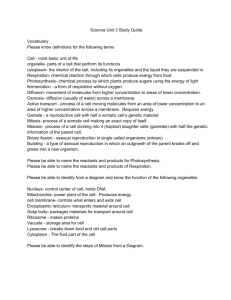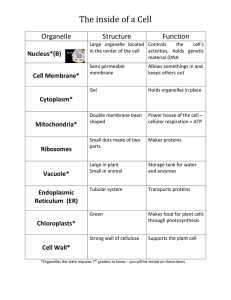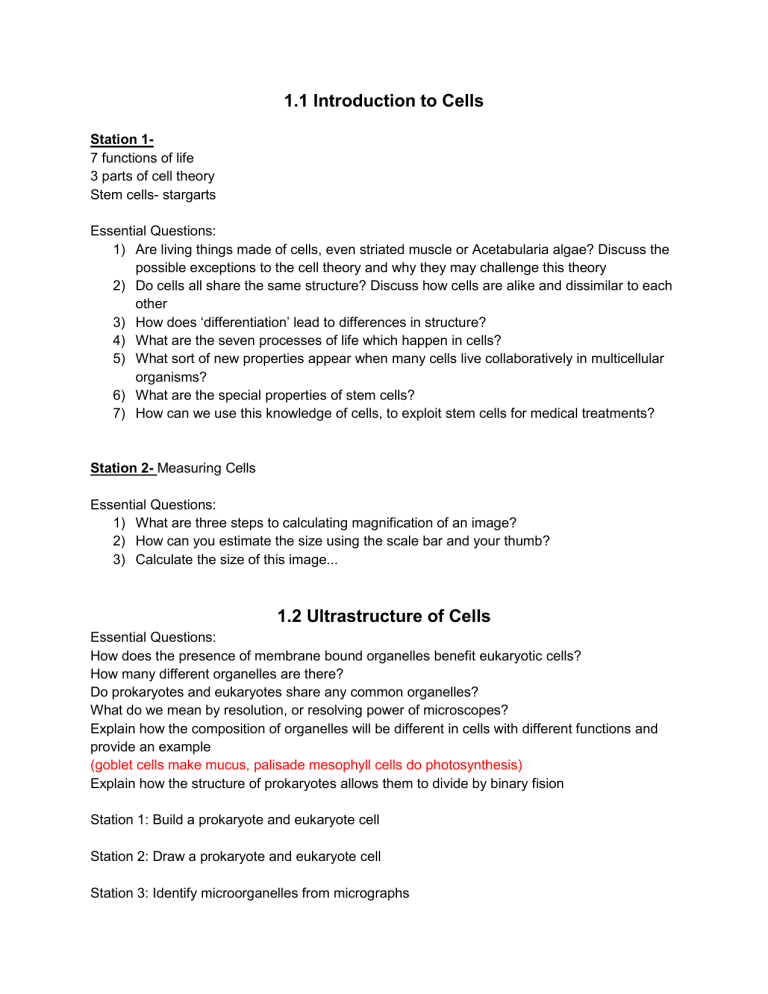
1.1 Introduction to Cells Station 17 functions of life 3 parts of cell theory Stem cells- stargarts Essential Questions: 1) Are living things made of cells, even striated muscle or Acetabularia algae? Discuss the possible exceptions to the cell theory and why they may challenge this theory 2) Do cells all share the same structure? Discuss how cells are alike and dissimilar to each other 3) How does ‘differentiation’ lead to differences in structure? 4) What are the seven processes of life which happen in cells? 5) What sort of new properties appear when many cells live collaboratively in multicellular organisms? 6) What are the special properties of stem cells? 7) How can we use this knowledge of cells, to exploit stem cells for medical treatments? Station 2- Measuring Cells Essential Questions: 1) What are three steps to calculating magnification of an image? 2) How can you estimate the size using the scale bar and your thumb? 3) Calculate the size of this image... 1.2 Ultrastructure of Cells Essential Questions: How does the presence of membrane bound organelles benefit eukaryotic cells? How many different organelles are there? Do prokaryotes and eukaryotes share any common organelles? What do we mean by resolution, or resolving power of microscopes? Explain how the composition of organelles will be different in cells with different functions and provide an example (goblet cells make mucus, palisade mesophyll cells do photosynthesis) Explain how the structure of prokaryotes allows them to divide by binary fision Station 1: Build a prokaryote and eukaryote cell Station 2: Draw a prokaryote and eukaryote cell Station 3: Identify microorganelles from micrographs 1.3 and 1.4 Membrane Structure and Function Essential questions 1) Why do the lipid tails of phospholipids attract each other? 2) How does a phospholipid bilayer prevent the loss of water from cells? 3) How can proteins attach to the bilayer? 4) What functions can membrane proteins have within cells? 5) What other substances are found in teh plasma membrane in addition to protein and phospholipid? 6) Outline the evidence which led to the falsification of the davson-danielli model to support the singer nicolson model Station 1- Draw a diagram of the fluid mosaic model Station 2- Explain how evidence from electron microscopy led to the proposal of the Davson Danielli model Essential Questions: 1) How can cells control the movement of substances through the plasma membrane using the membrane proteins? 2) How can the cell take in substances, like food particles, using membrane fluidity? 3) What is the difference between hypotonic and hypertonic solutions? 4) What functions do cholesterol in mammalian membranes provide? 5) Describe the structure and function of sodium-potassium pumps for active transport and potassium channels for facilitated diffusion in axons 6) Why must organs to be used in medical procedures be bathed in a solution with the same osmolarity as the cytoplasm? Station 1Osmosis and diffusion practions Station 2Estimation of osmolarity in tissues by bathing samples in hypotonic and hypertonic solutions When a sample of cells is 50% plasmolysed we say that the solution they are bathed in has the same salt concentration as their cytoplasm. Estimate the concentration of the cytoplasm of the onion cells using the graph below Station 3 Build a fluid mosaic model/Draw the fluid mosaic model 1.5 Origin of cells and 1.6 mitosis Essential Questions: 1) What is the role of cell division in the origin of life? 2) Where did the first cells come from? 3) How do cells join together? 4) What would happen if one cell engulfed another without killing it? 5) What are the stages in cell division by mitosis? 6) How do cells control the cell cycle? 7) What caused cell division to go wrong and become cancer? 8) What evidence from pasteurs experiments proved that spontaneous generation of cells and organism does not occur? 9) What is the correlation between smoking and incidence of cancers (draw a rudimentary graph to show this) Station 1Identification of phases of mitosis in cells viewed with a microscope or micrograph Station 2Determination of a mitotic index from a micrograph

